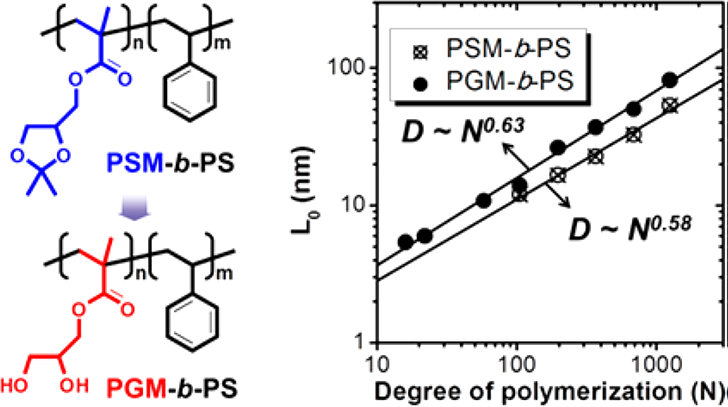Sub-5 nm Pitch Lamellar Microdomains by Chemical Transformations
A method of fabricating microphase separated block copolymer thin films with ordered, sub-5 down to sub-3 nm full pitch lamellar microdomains.
Current photolithographic processes are generally unable to achieve size scale features in the single nanometer range, which is highly desirable for microelectronic and storage devices. While self-assembly of block copolymers (BCPs) offers promise in this regard, this approach faces challenges relating to regulating the orientation of microdomains, casting uniform ultrathin films, and production of nanostructures with good lateral ordering. Beyond that, successful pattern transfer of the small microdomains relies not only on the proper orientation of the microdomains but also on the high etch contrast between the copolymer components, since the film thickness is reduced.
This invention provides a simple method of fabricating microphase separated block copolymer thin films with ordered, sub-5 down to sub-3 nm full pitch lamellar microdomains. The method involves the use of acid vapor hydrolysis to convert two hydrophobic blocks of a block copolymer into one hydrophilic block and one hydrophobic block, resulting in self-assembly of the copolymer and its transformation in the solid state into microphase separated and ordered lamellar microdomain.

The thin films provided by this method possess the smallest lamellar microdomains ever to have been achieved with block copolymers. The method involves a simple process that does not require the use of any additives for the solid state conversion of block copolymers from a disordered material to a microphase separated material. Most importantly, the method enables the generation of ultra-high-resolution lithographic templates.
Nanolithographic templates for:
- Nanoelectronics
- Storage media
- Separation media
US Non-Provisional Patent Application 16/179,078 2020024375 November 2, 2018.
Prototype demonstration.
Available for licensing or collaboration.
Macromolecules 2017, 50, 18, 7148-7154
Patent Information:
| App Type |
Country |
Serial No. |
Patent No. |
Patent Status |
File Date |
Issued Date |
Expire Date |
|